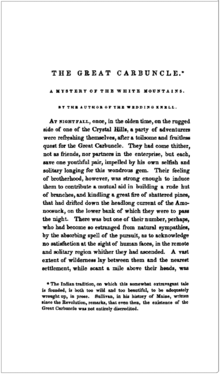The Great Carbuncle

"The Great Carbuncle" is a short story by Nathaniel Hawthorne. It first appeared in December 1835 before being included in the collection Twice-Told Tales in 1837.
Plot synopsis
In the White Mountains, a band of eight adventurers gathers together. They are each on a personal quest for the Great Carbuncle, a brilliant gem legendary in its elusiveness. The adventurers are as follows:
- The Seeker: a man sixty years of age who has sought the Great Carbuncle nearly his entire life. He says when he finds the Carbuncle he will die alongside it.
- Doctor Cacophodel: a chemist. He hopes to perform many tests on the Carbuncle and make many copies of it.
- Master Ichabod Pigsnort: a merchant, who wishes to sell the Carbuncle to the highest bidder.
- The Cynic: a bespectacled man with a constant sneer. He considers the hopes of the other adventurers futile. He seeks the Carbuncle to prove to everyone that it doesn't exist.
- The Poet: He hopes the Carbuncle will bring him inspiration.
- Lord de Vere: a wealthy prince, who would use the Carbuncle's brilliance as a symbol of his family's greatness for posterity.
- Matthew and Hannah: newlyweds, who wish to use the gem as a light in their household and as a conversation piece.
The next morning, Matthew and Hannah wake up realizing that the others have left before them. Even though they fear they have lost the Carbuncle, they take their time in preparing for their morning's adventure.
They begin to climb a great mountain. They soon fear they will be lost, until they spy a great red brilliance. They realize it is the Carbuncle. Beneath the Carbuncle, they see the figure of the Seeker, who has died trying to reach the gem. The Cynic approaches them and claims that he cannot see the Carbuncle. He removes his glasses and is immediately blinded by the gem's brilliance. Matthew and Hannah decide the gem is too brilliant for their household, and they leave it where it lies.
Publication history
Hawthorne was informed by a trip to Vermont and New Hampshire beginning in September 1832. "The Great Carbuncle" was published in the December 1835 issue of the New-England Magazine as the second (and final) installment of his series "Sketches from Memory, By a Pedestrian", after "The Ambitious Guest" in the previous issue.[1]
Analysis
Hawthorne explores the importance of honesty, simplicity, and selflessness in "The Great Carbuncle." These positive characteristics are most often demonstrated by Hannah and Matthew during the search for the Carbuncle; they sacrifice personal gain, alter their goals, and pivot their actions to assist others for the good of the group.
By contrast, characters' selfish motivations and greed elicit negative results. Each character has their own fantasy related to the stone: Dr. Cacaphodel wants to publish his findings for profit, the cynic wants to prove that he's right, and the Poet wanted to keep it to insure his writing. Each of these characters meet a different tragic fate related to what they desired to use the stone for. The story reinforces Hawthorne's value of selflessness and simplicity as opposed to selfishness and greed.
This story also suggests that hardwork and determination do not guarantee success. Though most of the characters are experts in their given fields, their knowledge does not help them at all.
References
External links

